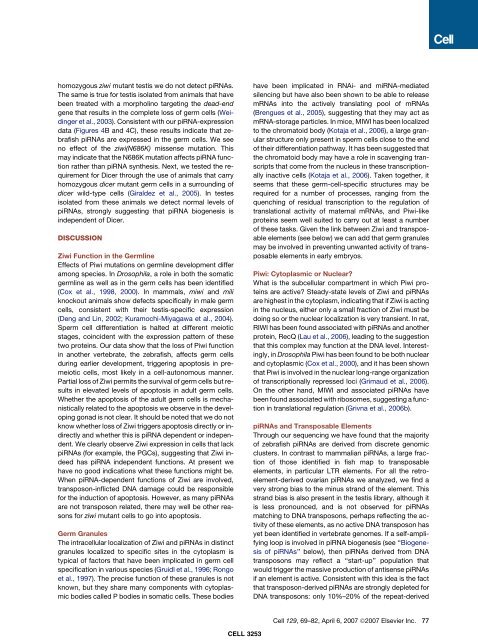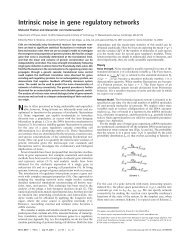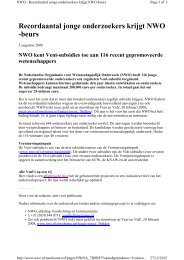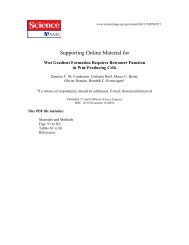A Role for Piwi and piRNAs in Germ Cell ... - Hubrecht Institute
A Role for Piwi and piRNAs in Germ Cell ... - Hubrecht Institute
A Role for Piwi and piRNAs in Germ Cell ... - Hubrecht Institute
Create successful ePaper yourself
Turn your PDF publications into a flip-book with our unique Google optimized e-Paper software.
homozygous ziwi mutant testis we do not detect <strong>piRNAs</strong>.<br />
The same is true <strong>for</strong> testis isolated from animals that have<br />
been treated with a morphol<strong>in</strong>o target<strong>in</strong>g the dead-end<br />
gene that results <strong>in</strong> the complete loss of germ cells (Weid<strong>in</strong>ger<br />
et al., 2003). Consistent with our piRNA-expression<br />
data (Figures 4B <strong>and</strong> 4C), these results <strong>in</strong>dicate that zebrafish<br />
<strong>piRNAs</strong> are expressed <strong>in</strong> the germ cells. We see<br />
no effect of the ziwi(N686K) missense mutation. This<br />
may <strong>in</strong>dicate that the N686K mutation affects piRNA function<br />
rather than piRNA synthesis. Next, we tested the requirement<br />
<strong>for</strong> Dicer through the use of animals that carry<br />
homozygous dicer mutant germ cells <strong>in</strong> a surround<strong>in</strong>g of<br />
dicer wild-type cells (Giraldez et al., 2005). In testes<br />
isolated from these animals we detect normal levels of<br />
<strong>piRNAs</strong>, strongly suggest<strong>in</strong>g that piRNA biogenesis is<br />
<strong>in</strong>dependent of Dicer.<br />
DISCUSSION<br />
Ziwi Function <strong>in</strong> the <strong>Germ</strong>l<strong>in</strong>e<br />
Effects of <strong>Piwi</strong> mutations on germl<strong>in</strong>e development differ<br />
among species. In Drosophila, a role <strong>in</strong> both the somatic<br />
germl<strong>in</strong>e as well as <strong>in</strong> the germ cells has been identified<br />
(Cox et al., 1998, 2000). In mammals, miwi <strong>and</strong> mili<br />
knockout animals show defects specifically <strong>in</strong> male germ<br />
cells, consistent with their testis-specific expression<br />
(Deng <strong>and</strong> L<strong>in</strong>, 2002; Kuramochi-Miyagawa et al., 2004).<br />
Sperm cell differentiation is halted at different meiotic<br />
stages, co<strong>in</strong>cident with the expression pattern of these<br />
two prote<strong>in</strong>s. Our data show that the loss of <strong>Piwi</strong> function<br />
<strong>in</strong> another vertebrate, the zebrafish, affects germ cells<br />
dur<strong>in</strong>g earlier development, trigger<strong>in</strong>g apoptosis <strong>in</strong> premeiotic<br />
cells, most likely <strong>in</strong> a cell-autonomous manner.<br />
Partial loss of Ziwi permits the survival of germ cells but results<br />
<strong>in</strong> elevated levels of apoptosis <strong>in</strong> adult germ cells.<br />
Whether the apoptosis of the adult germ cells is mechanistically<br />
related to the apoptosis we observe <strong>in</strong> the develop<strong>in</strong>g<br />
gonad is not clear. It should be noted that we do not<br />
know whether loss of Ziwi triggers apoptosis directly or <strong>in</strong>directly<br />
<strong>and</strong> whether this is piRNA dependent or <strong>in</strong>dependent.<br />
We clearly observe Ziwi expression <strong>in</strong> cells that lack<br />
<strong>piRNAs</strong> (<strong>for</strong> example, the PGCs), suggest<strong>in</strong>g that Ziwi <strong>in</strong>deed<br />
has piRNA <strong>in</strong>dependent functions. At present we<br />
have no good <strong>in</strong>dications what these functions might be.<br />
When piRNA-dependent functions of Ziwi are <strong>in</strong>volved,<br />
transposon-<strong>in</strong>flicted DNA damage could be responsible<br />
<strong>for</strong> the <strong>in</strong>duction of apoptosis. However, as many <strong>piRNAs</strong><br />
are not transposon related, there may well be other reasons<br />
<strong>for</strong> ziwi mutant cells to go <strong>in</strong>to apoptosis.<br />
<strong>Germ</strong> Granules<br />
The <strong>in</strong>tracellular localization of Ziwi <strong>and</strong> <strong>piRNAs</strong> <strong>in</strong> dist<strong>in</strong>ct<br />
granules localized to specific sites <strong>in</strong> the cytoplasm is<br />
typical of factors that have been implicated <strong>in</strong> germ cell<br />
specification <strong>in</strong> various species (Gruidl et al., 1996; Rongo<br />
et al., 1997). The precise function of these granules is not<br />
known, but they share many components with cytoplasmic<br />
bodies called P bodies <strong>in</strong> somatic cells. These bodies<br />
CELL 3253<br />
have been implicated <strong>in</strong> RNAi- <strong>and</strong> miRNA-mediated<br />
silenc<strong>in</strong>g but have also been shown to be able to release<br />
mRNAs <strong>in</strong>to the actively translat<strong>in</strong>g pool of mRNAs<br />
(Brengues et al., 2005), suggest<strong>in</strong>g that they may act as<br />
mRNA-storage particles. In mice, MIWI has been localized<br />
to the chromatoid body (Kotaja et al., 2006), a large granular<br />
structure only present <strong>in</strong> sperm cells close to the end<br />
of their differentiation pathway. It has been suggested that<br />
the chromatoid body may have a role <strong>in</strong> scaveng<strong>in</strong>g transcripts<br />
that come from the nucleus <strong>in</strong> these transcriptionally<br />
<strong>in</strong>active cells (Kotaja et al., 2006). Taken together, it<br />
seems that these germ-cell-specific structures may be<br />
required <strong>for</strong> a number of processes, rang<strong>in</strong>g from the<br />
quench<strong>in</strong>g of residual transcription to the regulation of<br />
translational activity of maternal mRNAs, <strong>and</strong> <strong>Piwi</strong>-like<br />
prote<strong>in</strong>s seem well suited to carry out at least a number<br />
of these tasks. Given the l<strong>in</strong>k between Ziwi <strong>and</strong> transposable<br />
elements (see below) we can add that germ granules<br />
may be <strong>in</strong>volved <strong>in</strong> prevent<strong>in</strong>g unwanted activity of transposable<br />
elements <strong>in</strong> early embryos.<br />
<strong>Piwi</strong>: Cytoplasmic or Nuclear?<br />
What is the subcellular compartment <strong>in</strong> which <strong>Piwi</strong> prote<strong>in</strong>s<br />
are active? Steady-state levels of Ziwi <strong>and</strong> <strong>piRNAs</strong><br />
are highest <strong>in</strong> the cytoplasm, <strong>in</strong>dicat<strong>in</strong>g that if Ziwi is act<strong>in</strong>g<br />
<strong>in</strong> the nucleus, either only a small fraction of Ziwi must be<br />
do<strong>in</strong>g so or the nuclear localization is very transient. In rat,<br />
RIWI has been found associated with <strong>piRNAs</strong> <strong>and</strong> another<br />
prote<strong>in</strong>, RecQ (Lau et al., 2006), lead<strong>in</strong>g to the suggestion<br />
that this complex may function at the DNA level. Interest<strong>in</strong>gly,<br />
<strong>in</strong> Drosophila <strong>Piwi</strong> has been found to be both nuclear<br />
<strong>and</strong> cytoplasmic (Cox et al., 2000), <strong>and</strong> it has been shown<br />
that <strong>Piwi</strong> is <strong>in</strong>volved <strong>in</strong> the nuclear long-range organization<br />
of transcriptionally repressed loci (Grimaud et al., 2006).<br />
On the other h<strong>and</strong>, MIWI <strong>and</strong> associated <strong>piRNAs</strong> have<br />
been found associated with ribosomes, suggest<strong>in</strong>g a function<br />
<strong>in</strong> translational regulation (Grivna et al., 2006b).<br />
<strong>piRNAs</strong> <strong>and</strong> Transposable Elements<br />
Through our sequenc<strong>in</strong>g we have found that the majority<br />
of zebrafish <strong>piRNAs</strong> are derived from discrete genomic<br />
clusters. In contrast to mammalian <strong>piRNAs</strong>, a large fraction<br />
of those identified <strong>in</strong> fish map to transposable<br />
elements, <strong>in</strong> particular LTR elements. For all the retroelement-derived<br />
ovarian <strong>piRNAs</strong> we analyzed, we f<strong>in</strong>d a<br />
very strong bias to the m<strong>in</strong>us str<strong>and</strong> of the element. This<br />
str<strong>and</strong> bias is also present <strong>in</strong> the testis library, although it<br />
is less pronounced, <strong>and</strong> is not observed <strong>for</strong> <strong>piRNAs</strong><br />
match<strong>in</strong>g to DNA transposons, perhaps reflect<strong>in</strong>g the activity<br />
of these elements, as no active DNA transposon has<br />
yet been identified <strong>in</strong> vertebrate genomes. If a self-amplify<strong>in</strong>g<br />
loop is <strong>in</strong>volved <strong>in</strong> piRNA biogenesis (see ‘‘Biogenesis<br />
of <strong>piRNAs</strong>’’ below), then <strong>piRNAs</strong> derived from DNA<br />
transposons may reflect a ‘‘start-up’’ population that<br />
would trigger the massive production of antisense <strong>piRNAs</strong><br />
if an element is active. Consistent with this idea is the fact<br />
that transposon-derived <strong>piRNAs</strong> are strongly depleted <strong>for</strong><br />
DNA transposons: only 10%–20% of the repeat-derived<br />
<strong>Cell</strong> 129, 69–82, April 6, 2007 ª2007 Elsevier Inc. 77






